The heathens of the world today, and you too, are all telling time according to the Roman system. Days begin at midnight (utterly insane!), days are divided into 24 Roman hours, each Roman hour is 60 Roman minutes, each Roman minute is 60 Roman seconds, and the Roman year begins in the dead of winter on the first day of the Roman month of January. The system has mass appeal because we are living in the days of the Fourth Kingdom which is Roman Christendom white supremacy. But the Romans obtained much of their system of time recognition from the ancient Babylonians. So the roots are as pagan as you can get.
But exactly how did the heathens come to divide the hour into 60 minutes and the minute into 60 seconds? It all begins with the word sexagesimal (also known as base 60 or sexagenary) which is a numeral system with 60 as its base. It originated after the Flood of Nakh (Noah) with the ancient Sumerians in the 3rd millennium BCE. It was passed down to the Babylonians, and ultimately to the Romans, and is still used—in a modified form—for measuring time, angles, and geographic coordinates.
In the 24th century BCE (post-Tower of Babal), the Sumerians were conquered by the Akkadians, who then fell to the Amorites (Canaanites), who rose to power and built the nation-state of Babylon, which peaked in the 18th century BCE. The Babylonians invented the degree and defined a circle as having 360 degrees because their “ideal” lunar year was 360 days (12 months of 30 days each). Hence the Babylonians believed the sun moves along the ecliptic approximately 1 degree per day and 360 degrees per year. Since the radius of a circle maps onto a circumscribed hexagon of six equilateral triangles a sixth of a circle forms a natural angle measure. In the numerals inherited from the Sumerians, a number’s sexagesimal value was easily inferred from this context.
Babylonian astronomers also began cataloging stars as early as the 14th century BCE. Astronomy flourished as they developed a profound understanding of solar and lunar cycles through empirical observations, and they could even predict eclipses. Babylonian star catalogs, all of which correctly assumed earth is a flat and motionless plane, served as the basis of astronomy for more than a thousand years despite the boom of the Middle Assyrian Empire, the Neo-Assyrian Empire, the Neo-Babylonian Empire, and the Persian Achaemenid Empire.
The conquests of Alexander the Great between 335 and 324 BCE helped spread Babylonian astronomy westward to Greece. The Babylonian star catalogs created such a strong association between astronomy and the Babylonian sexagesimal system that Greek (and later Roman) scholars kept on using it and this spilled over into navigation and trigonometry.
Following the miscalculations by Eratosthenes of Cyrene who in the first century BCE believed he was the first to prove earth is round (see the graphic below where his belief is shredded to pieces by me), Hipparchus of Nicaea adapted 360 degrees to quantify lines of longitude and latitude. Two centuries later in the Roman Empire, Ptolemy of Alexandria subdivided degree coordinates into 60ths (minutes) and 60ths of 60ths (seconds). This convention of “degrees, minutes and seconds” is still used today to plot locations on earth as well as the positions of stars.
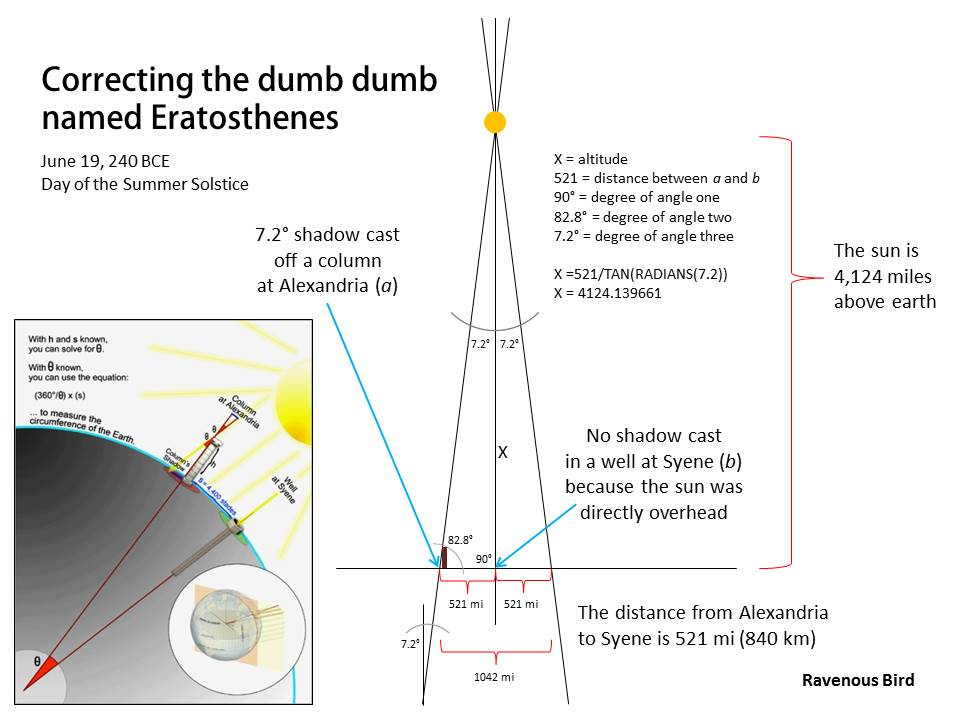
It is true that the sexagesimal number 60 is a superior and highly composite number. It has twelve factors, namely 1, 2, 3, 4, 5, 6, 10, 12, 15, 20, 30, and 60, of which 2, 3, and 5 are prime numbers. With so many factors, many fractions involving sexagesimal numbers are simplified. For example, one Roman-Babylonian hour can be divided evenly into sections of 30 minutes, 20 minutes, 15 minutes, 12 minutes, 10 minutes, 6 minutes, 5 minutes, 4 minutes, 3 minutes, 2 minutes, and 1 minute. 60 is the smallest number that is divisible by every number from 1 to 6; that is, it is the lowest common multiple of 1, 2, 3, 4, 5, and 6.
However, having said all of that, and having explained how the heathens of today tell time and bend the world into a ball the way they do, we must point out that the number 60 meant absolutely nothing to the man who wrote the Thorah (law) in the 15th century BCE named Mashah. Neither did the number 60 hold any significance at all, whatsoever, to the prophets who came after Mashah and who wrote the books of the Thaiodah (testimony).
The truth is that as we speak a little rock is being carved out of a mountain without hands (Dan 2:34) which will defy the Roman-Babylonian ways, including its languages and also its method of telling time. This rock will return to speak the pure language of its ancestors and it will tell time the way it is documented in their sacred writings (i.e. Thorah and Thaiodah). It’s happening now.
The rock will strike the great image of King Nebuchadnezzar’s dream on its feet and grow into a mountain that fills the whole world (Dan 2:35). Meaning our system will total eclipse the Roman-Babylonian system and have the mass appeal that the Roman-Babylonian system currently enjoys. In fact, our system will be the only system anyone is allowed to use anywhere in the world. Our kingdom will dominate the earth and our kingdom will never be destroyed (Dan 2:44-45).
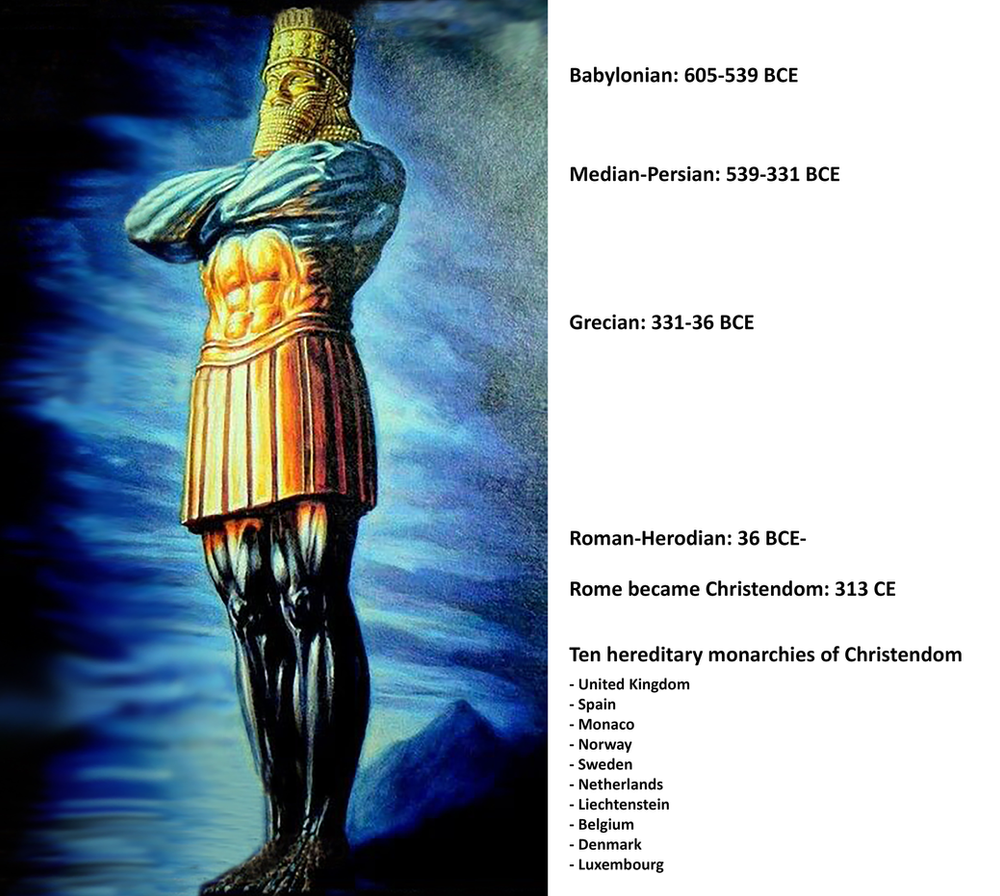
So what exactly is our system of time recognition per Thorah and per Thaiodah?
According to these writings, there are 9 parts of a day and 9 parts of a night when the period of daylight is equal to the period of nighttime at the equiloxes. That means a day is 18 parts not 24. Let’s prove this.
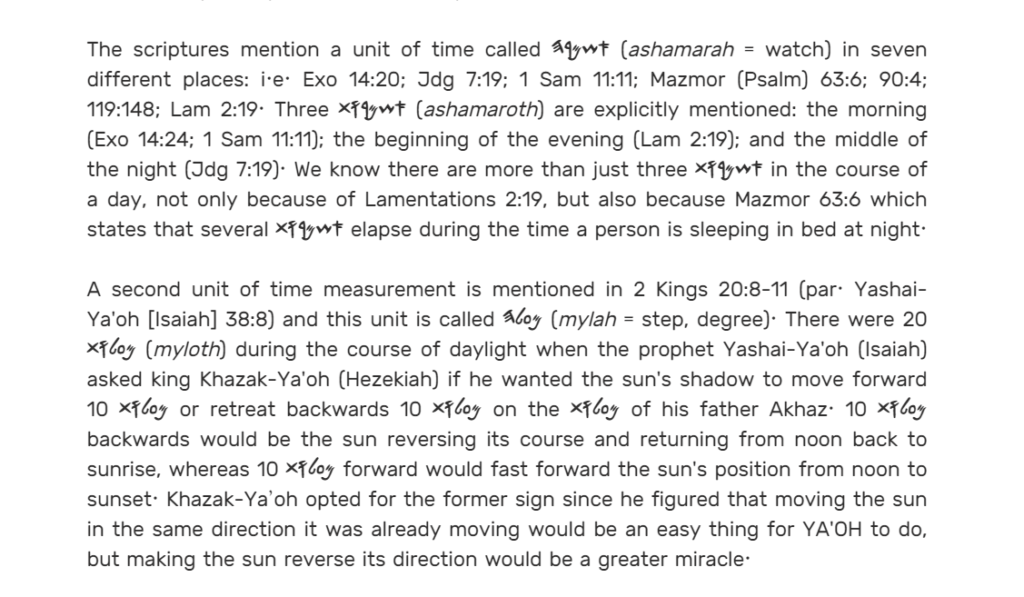
If you pay careful attention to this wonder recounted in 2 Kings 20:8-11 it is only conceivable if earth is a flat and motionless plane and the sun is orbiting the north pole at the earth’s center. The sun moves inside the firmament which is its tabernacle and it is high above the face of the earth which is a circle. From a biblical standpoint, there is no way around this conclusion. No way at all. The king was asking for the sun to stop and move in the opposite direction, which means the sun is moving and not earth. You either believe this happened or you don’t.
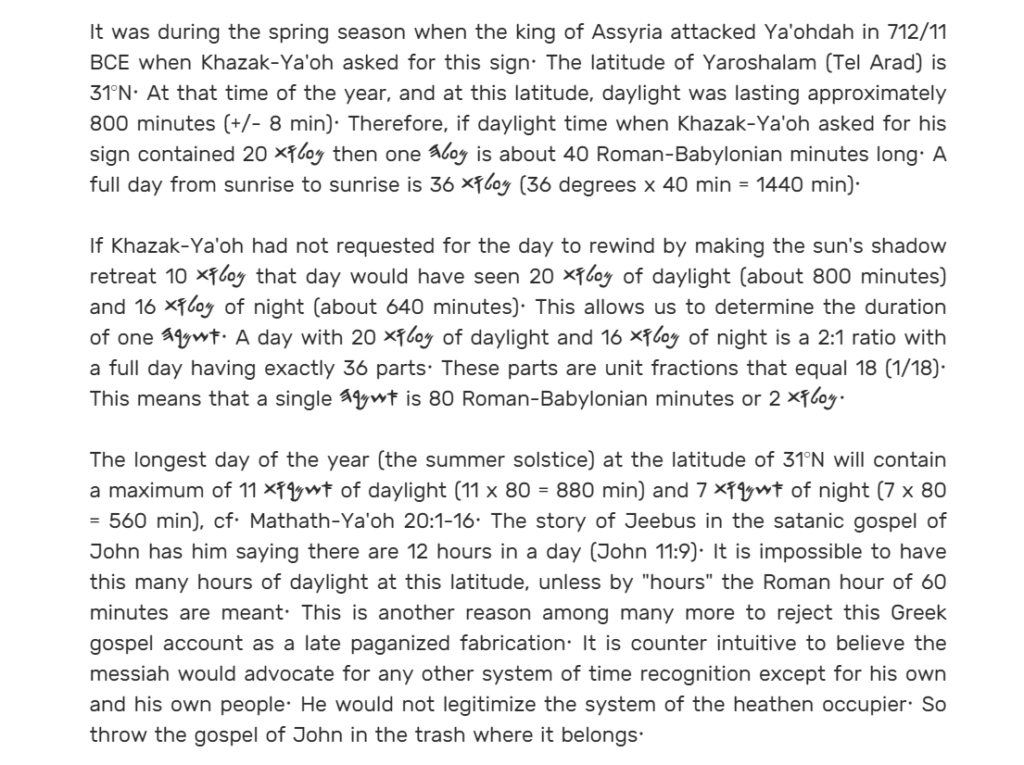
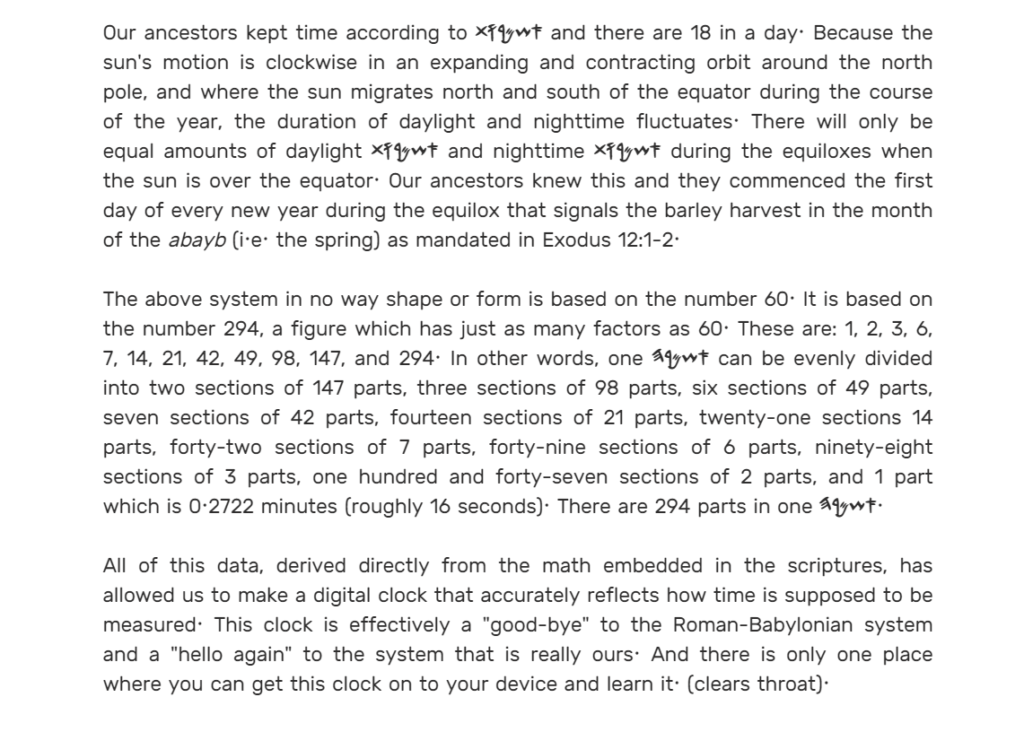
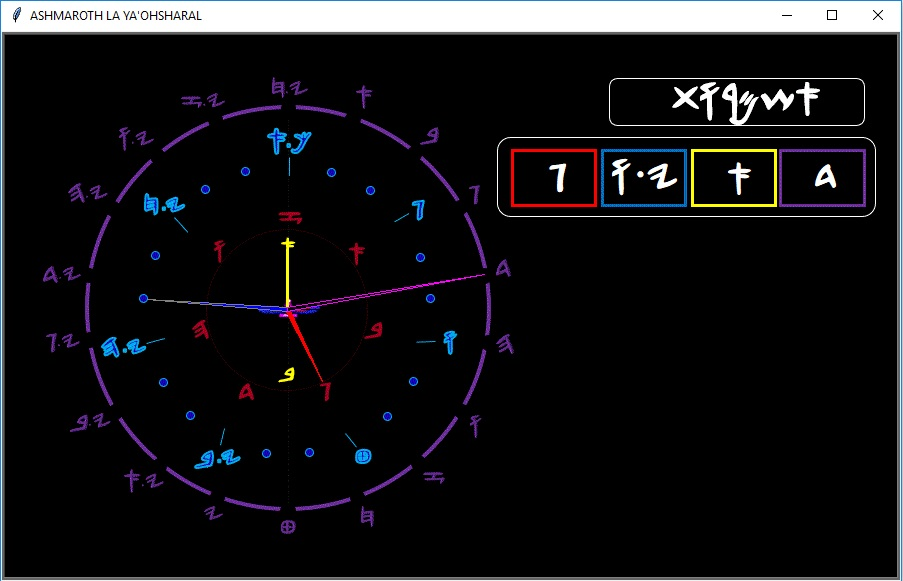
What about the circle? As I said earlier, the heathens came up with 360 degrees for the circle based on their ideal lunar calendar year of 360 days. This despite the fact that a lunar year is never 360 days. It is always 354 or 355 days. The correct duration of the year from equilox to equilox is 364 days. This is 1.24 days shorter than the solar year of 365.24 days, from equinox to equinox, but the number 364 is evenly divided by 7 and that makes 364 the ideal length of the solar year. Hence a circle is 364 degrees not 360. The three angles of a triangle are 182 degrees not 180, and a right angle is 91 degrees not 90.
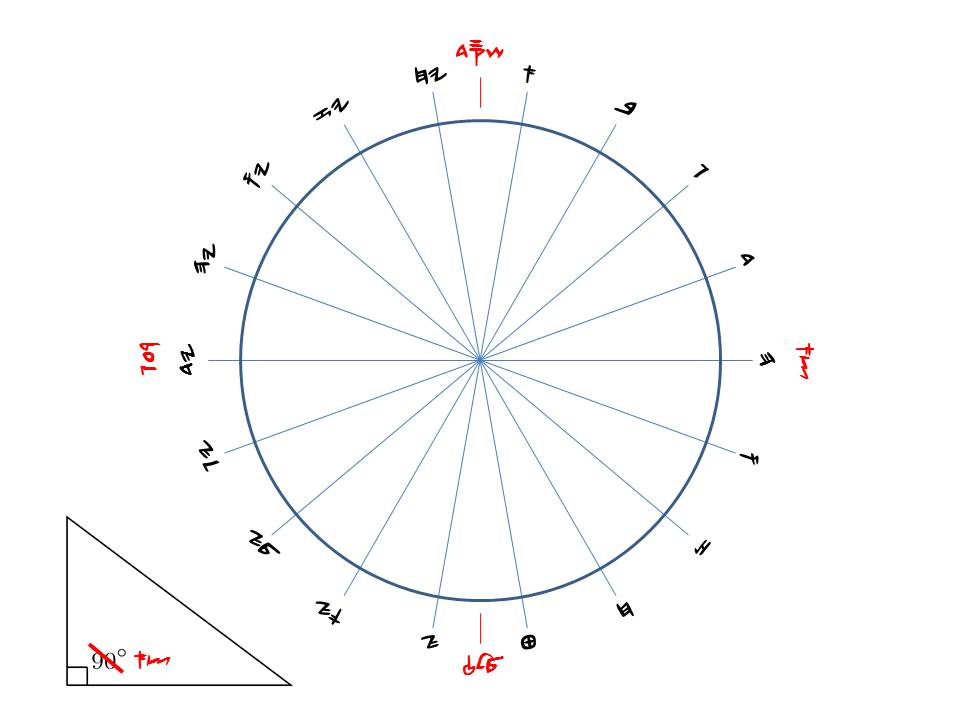
It takes 294 years – the same number of parts in one אשמרה – for an unadjusted 364-day calendar to cycle through the seasons and return to the same starting point. To prevent this drift from happening you need to add 52 intercalary weeks for 364 days to the calendar in the course of 294 years. This is how a 364-day calendar is maintained so that it stays in sync with the sun’s motion.
For millennia, ancient heathen civilizations looked to the sky to measure the big units of time. Our ancestors did not need to because the Creator instructed them to divide the year into weeks of seven days each. There’s the “year,” which is the number of weeks it takes the sun to complete one marathon above the earth from equilox to equilox (7 x 52 = 364); there’s the “month,” which has nothing to do with the moon itself but is 1/12th of a 364-day calendar year, i.e. nine months of 30 days and four months of 31 days; there’s the “week,” which is exactly seven days; and there’s the “day,” which is 18 אשמרות for the duration of one orbit of the sun above the flat earth plane and around the north pole from one sunrise to the next.
The restoration of the holy name in the far east where the sun rises has triggered the restoration of all things that His chosen people have lost because of their sins. His mercy endures forever and His name will have mass appeal.
His name is YA’OH
Always has been. Always will be.
#EXODUS2023

Chabod l’Ya’oh ‼️ ✊🏾
Aman HALALO ath YA’OH